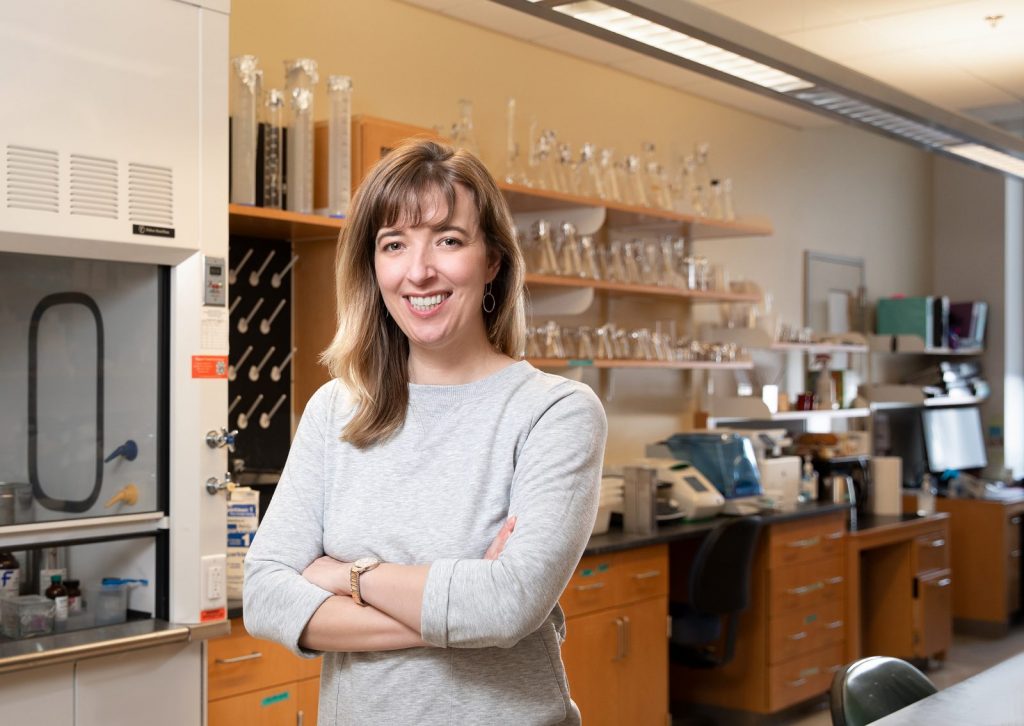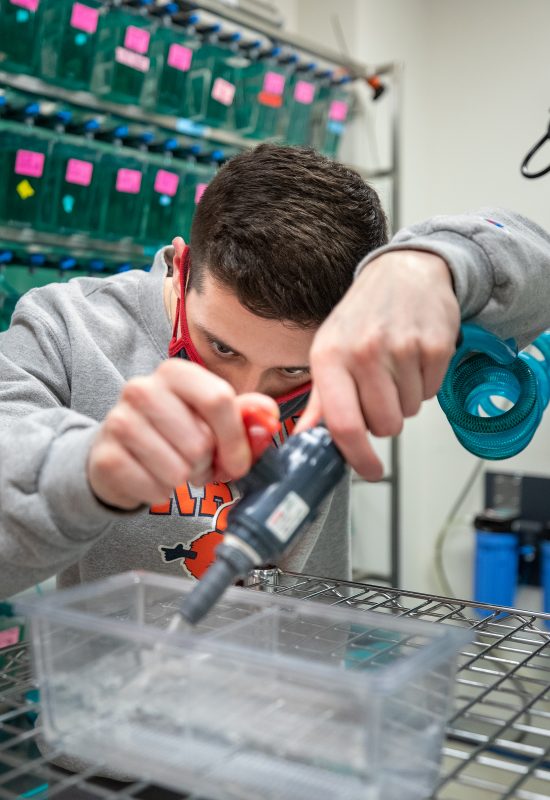A century ago, the great Victorian polymath D’Arcy Thompson famously blended science and art to understand how forms arise in biology. Today in the heady corridors of the Life Sciences Complex, a Syracuse University biologist carries on the tradition using new and emerging technologies.
Heidi Hehnly, a biotechnologist in the College of Arts and Sciences, aims to determine the molecular origins of disease while fostering a greater appreciation for the role of creativity in research. “Understanding the nature of complex biological functions enables us to develop and design materials to address global challenges in health and medicine,” says Hehnly, who also collaborates with faculty across disciplines in the University’s BioInspired Institute.

Building Bridges
Hehnly is using three major grant awards to push the boundaries of cellular and developmental biology. She landed two of them last fall—$1.2 million from the National Institutes of Health (NIH) to analyze the link between tissue formation and developmental disorders, and $562,000 from the Department of Defense to explore a cancer-causing gene. She is also in the middle of a $1.7-million NIH project devoted to ciliopathies—genetic mutations stemming from defective or dysfunctional cilia on cells.
The two NIH projects use advanced microscopy techniques to study zebrafish, which make great lab subjects because of their genetic similarity to humans. “About 84% of genes associated with human disease have a counterpart in zebrafish. We also share many organs and tissues with them,” says Hehnly, who came to Syracuse University in 2018 from SUNY Upstate Medical University.
Her latest NIH project focuses on organs with tubular passageways known as lumina. The placement of such organs, like the heart or intestines, is controlled by a molecular process called left-right patterning. Any deviation in this patterning during cell division can spark a developmental disorder. Hehnly studies the organ responsible for left-right patterning in zebrafish to probe the final stage of cell division, known as cytokinesis. She and her colleagues have found that cytokinetic bridges occur during tissue formation in this organ, thus affecting the structure and function of lumina, cilia and tissue organization. “We’ve used a special laser to destroy a bridge connecting two diseased cells,” beams Hehnly, who hopes to find additional ways to pinpoint the cause of certain cell pathologies.
Hehnly’s other NIH project involves a molecular structure called the centrosome, from which primary cilia grow. These hairlike projections are akin to antennae, enabling the cell to receive and process information. Any compromise to the centrosome or its associate cilium can trigger cardiovascular, neurological or renal problems. An interesting outgrowth of this project has been the construction of a laser-spinning confocal microscope, which uses pinholes to block out-of-focus light, creating superior contrast and resolution. “It also enables us to generate 3D images of organelles in cells and to track changes that occur in cells over time,” explains Hehnly, who earned a Ph.D. in molecular physiology and biophysics from the University of Iowa.
Breaking Down Barriers

Hehnly’s Department of Defense project focuses on a gene called PLK1, which is critical for cell division in zebrafish but has been linked to prostate cancer in humans. Hehnly is currently developing substances to block the growth of PLK1, as well as the blood vessels where tumors grow. Such advanced techniques, she says, are at the frontier of precision medicine.
Thomas Vincent Cammerino ’23, who has worked in Hehnly’s lab for two years, credits her for sparking his interest in research. “Heidi has provided me with the tools and resources to be successful. Because of her mentorship, I plan to pursue an M.D.-Ph.D.,” says the biology major.
Such passion for teaching and research is not lost on fellow faculty members. “Having students develop scientific hypotheses and then test them experimentally forces them out of their comfort zone,” says Carlos A. Castañeda, an assistant professor of biology and chemistry. Hehnly’s integrative approach, he explains, imparts critical thinking skills to students, turning them into “curious and thoughtful” researchers.
BioInspired director M. Lisa Manning agrees, adding that Hehnly’s deep understanding of complex biological processes pays dividends in the lab and the classroom. “She’s a genius at microscopy and manipulating biological processes with light. Her infectious enthusiasm and natural curiosity help break down barriers between disciplines.”
Blending Art and Science
Beyond the lab, Hehnly co-founded an event series called the Bio-Art Mixer with Boryana Rossa, an art video professor in the College of Visual and Performing Arts. Named for a new type of art incorporating the biological sciences, the series presents interdisciplinary talks, lectures and exhibitions intended to inspire conversations about the environment and human-nature interaction.
“Heidi is a scientist and an artist who seeks connections between different ideas and knowledge,” says Rossa, based in the Department of Transmedia. “Her ability to see beyond specialization leads to great creativity and innovation, and the ability to produce visionary ideas.”
– by Rob Enslin
